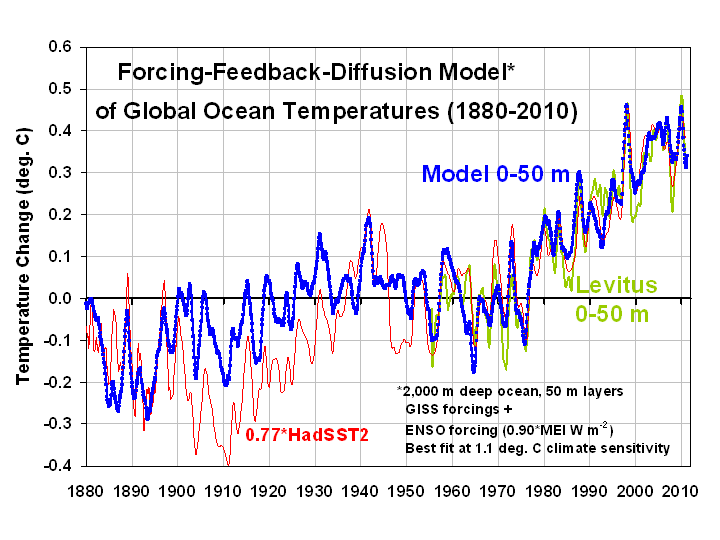This is an update of my last post, where I described the results of a Forcing-Feedback-Diffusion (FFD) model of ocean temperature variations to 2,000 meters deep.
The model assumes the GISS-assumed forcings since 1880, including greenhouse gases, volcanoes, and manmade aerosol pollution. To those, I added a forcing term proportional to El Nino/La Nina activity, equal to 0.9 x MEI (Multivariate ENSO Index), in Watts per sq. meter. I adjusted ocean turbulent heat diffusion coefficients and the El Nino term until I got a correlation of 0.95 between the model temperature variations for the surface-50 meter ocean layer for the period 1955 through 2010. It also matches the warming trend in the 650-700 m layer during 1955-2010, which is the deepest layer for which we have long-term data to compare to.
I’ve now extended the model simulation back to 1880, since GISS forcings go back that far, and NOAA has an MEI reconstruction of El Nino/La Nina activity that goes back even before that. The optimum climate sensitivity was 1.1 deg. C for a doubling of atmospheric CO2, a climate sensitivity so low that the IPCC considers it very unlikely.
The results look like this (click on image for full size version):

Note I have also added the HadSST2 sea surface temperatures, scaled to match the variability of the Levitus 0-50 meter layer during 1955-2010.
The match is pretty good, except the model does not capture the exceptionally cool conditions during 1900-1935. Since this was a period of low sunspot activity, it could be this is a cosmic ray effect on global cloud cover.
The important message here is that this simulation was done with a very low climate sensitivity, corresponding to only about 1/3 the warming rate the IPCC projects for the future in response to increasing atmospheric CO2.
A Note on Deep Ocean Heat Storage
For those interested in the deep-ocean heat storage issue, the assumed model diffusivities I used (which average 3.7 x 10-4 m2/sec down to 2,000 meters depth) are considerably larger than what is usually assumed in climate model simulations. If I use a diffusivity much closer to what is traditionally used (1.2 x 10-4 m2/sec), then I have to reduce the model sensitivity to 0.9 deg. C for 2XCO2 in order to still match the near-surface warming trend, otherwise the model warms too much compared to observations.

 Home/Blog
Home/Blog



